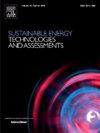Sustainable biodiesel from Pyrus pashia seed oil using Sauromatum venosum-derived CdO nanoparticles
IF 7
2区 工程技术
Q1 ENERGY & FUELS
Sustainable Energy Technologies and Assessments
Pub Date : 2025-05-31
DOI:10.1016/j.seta.2025.104372
引用次数: 0
Abstract
Sustainable and cost-effective energy alternatives are necessary to tackle both greenhouse gas emissions and fossil fuel depletion Therefore, the use of biofuels as an alternative is most appropriate. This study explores the biodiesel synthesis from novel non-edible Pyrus pashia L. seed oil utilizing a cadmium oxide (CdO) as a novel phyto-derived solid nanocatalyst from Sauromatum venosum fruit a bio-based raw material, utilizing high-temperature furnace heating at 500 ◦C. CdO nanoparticles were analyzed using Fourier-transform infrared spectroscopy (FT-IR), X-ray diffraction (XRD), energy-dispersive X-ray spectroscopy (EDX), and scanning electron microscopy (SEM). Optimal biodiesel production conditions were established using Response surface methodology (RSM) at a methanol-to-oil molar ratio of 9:1, a reaction temperature of 80 °C, a reaction time of 105 min, and a catalyst loading of 0.74 wt%, yielding 97.12 %. The synthesized biodiesel was analyzed using FT-IR spectroscopy and gas chromatography-mass spectrometry (GC–MS). The physicochemical analysis met European (EN 14214) and American (ASTM D 6751) biodiesel standards, with favorable properties such as density (0.87 kg/L), acid value (0.24 mg KOH/g), kinematic viscosity (3.4 and 5.0 cSt at 40 °C), flash point (90 °C), cloud point (9 °C), pour point (13 °C), and low sulfur content (0.004 wt%). The catalyst’s reusability was also examined after seven cycles, demonstrating a gradual decrease in efficiency. However, even in the seventh cycle, biodiesel production remained high at 86 % efficiency, demonstrating the approach’s potential for long-term biodiesel synthesis. The findings of this study led to the conclusion that non-conventional and non-edible oil seeds of Purus pashia, as well as green Sauromatum venosum-derived CdO nanocatalyst, are viable, low-cost, sustainable, and highly reactive contenders for the future biodiesel industry, with the potential to mitigate energy glitches while also improving the socioeconomic well-being of communities on a global scale.

可持续生物柴油从梨pashia籽油使用蛇毒衍生的CdO纳米颗粒
要解决温室气体排放和化石燃料枯竭的问题,必须有可持续和具有成本效益的替代能源。因此,使用生物燃料作为替代能源是最合适的。本研究利用氧化镉(CdO)作为一种新型植物衍生固体纳米催化剂,利用500℃的高温炉加热,从生物基原料Sauromatum venosum果实中合成生物柴油。采用傅里叶变换红外光谱(FT-IR)、x射线衍射(XRD)、能量色散x射线光谱(EDX)和扫描电子显微镜(SEM)对CdO纳米颗粒进行了分析。采用响应面法(RSM)确定了生物柴油的最佳生产条件:甲醇与油的摩尔比为9:1,反应温度为80℃,反应时间为105 min,催化剂负载为0.74 wt%,产率为97.12%。采用红外光谱(FT-IR)和气相色谱-质谱(GC-MS)对合成的生物柴油进行分析。理化分析符合欧洲(EN 14214)和美国(ASTM D 6751)生物柴油标准,具有良好的性能,如密度(0.87 kg/L),酸值(0.24 mg KOH/g),运动粘度(3.4和5.0 cSt, 40°C),闪点(90°C),浊点(9°C),倾点(13°C)和低硫含量(0.004 wt%)。催化剂的可重复使用性也在七个循环后进行了测试,表明效率逐渐下降。然而,即使在第七个循环中,生物柴油的生产效率仍然高达86%,这表明该方法具有长期合成生物柴油的潜力。这项研究的结果得出结论,非常规和非食用的pashia油籽,以及绿色的Sauromatum venosum衍生的CdO纳米催化剂,是未来生物柴油行业可行的、低成本的、可持续的、高活性的竞争者,具有缓解能源故障的潜力,同时也改善了全球范围内社区的社会经济福祉。
本文章由计算机程序翻译,如有差异,请以英文原文为准。
求助全文
约1分钟内获得全文
求助全文
来源期刊

Sustainable Energy Technologies and Assessments
Energy-Renewable Energy, Sustainability and the Environment
CiteScore
12.70
自引率
12.50%
发文量
1091
期刊介绍:
Encouraging a transition to a sustainable energy future is imperative for our world. Technologies that enable this shift in various sectors like transportation, heating, and power systems are of utmost importance. Sustainable Energy Technologies and Assessments welcomes papers focusing on a range of aspects and levels of technological advancements in energy generation and utilization. The aim is to reduce the negative environmental impact associated with energy production and consumption, spanning from laboratory experiments to real-world applications in the commercial sector.
 求助内容:
求助内容: 应助结果提醒方式:
应助结果提醒方式:


